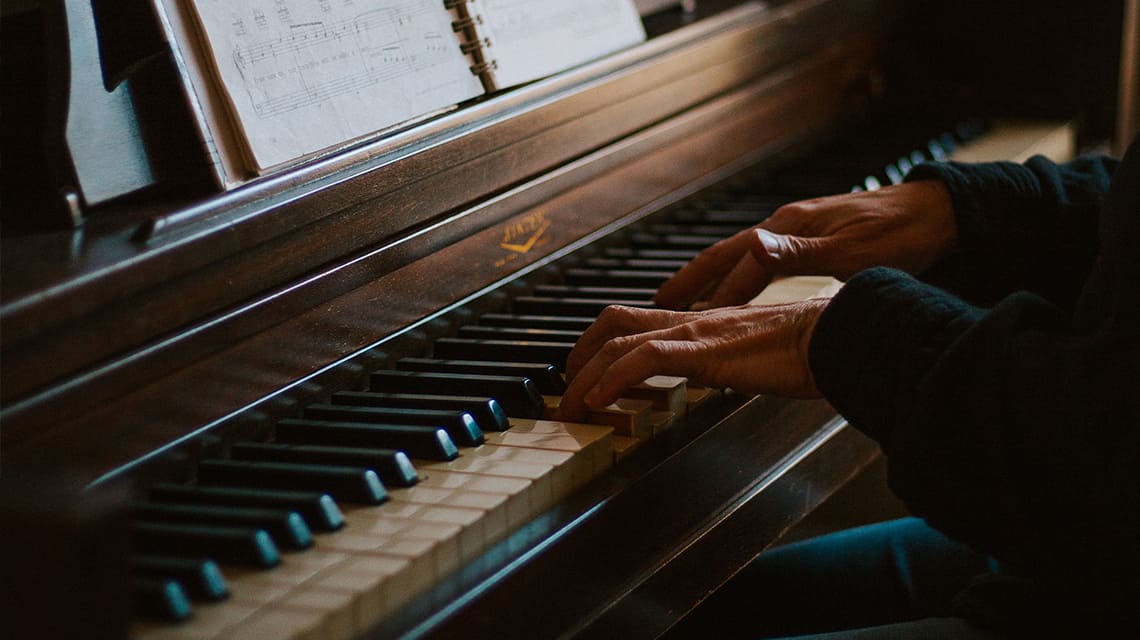How To Get Started Playing Classical Music
Playing classical music is a worthy goal that many pianists strive for. However, if you aren’t introduced to classical music early in your piano study, it may seem difficult to find an obvious entry point. Many of the classics that are “bucket list” pieces are actually quite difficult to learn and

Playing classical music is a worthy goal that many pianists strive for. However, if you aren’t introduced to classical music early in your piano study, it may seem difficult to find an obvious entry point.
Many of the classics that are “bucket list” pieces are actually quite difficult to learn and master. It wouldn’t make sense to try to tackle some of the most challenging classical pieces of music if you’ve never played any classics before. There are a lot of stylistic nuances and technical challenges in classical music. A more logical path would be to learn more foundational entry-level classics and to work your way up to the bigger pieces.
For example, Beethoven’s Moonlight Sonata or “Für Elise,” Debussy’s “Clair de Lune,” Mozart’s “Rondo Alla Turca,” and many other “popular” classics are common requests. These pieces all require advanced reading and technical skills that take many years to develop.
What is “Classical” Music?
It’s important to understand that when people talk about classical music as a whole, it encompasses four different eras of music.
- Baroque
- Classical
- Romantic
- Contemporary
Each of these genres of music has distinct stylistic and historical differences that make them unique from one another. Once pianists have explored all four genres of music, they are usually drawn to one or two of them. Let’s look at each era of Classical music and find music that is a good starting place for intermediate pianists.
The music we’re looking at today isn’t necessarily difficult, but it does require strong reading skills and a good technical foundation of scales and chords. As you are learning classics, you’ll want to turn more of your focus on how to play the notes, rather than what notes to play.
Baroque
The Baroque era was from approximately from 1600 to 1750. Famous composers from this time include Johann Sebastian Bach, George Frederic Handel, and Domenico Scarlatti.
It’s important to know that the primary keyboard instrument during this time was not the piano, but the harpsichord. This means that any Baroque music that you are learning on the piano, would have been originally intended to be played on the harpsichord. If you’ve never heard what a harpsichord sounds like, check out this video of Bach’s “Minuet in G BWV Anh114” being played on the harpsichord.
Here are some distinct features to take into consideration as you are exploring the Baroque style:
1. Much of the music was written in counterpoint. Counterpoint is the art of combining two or more melodies that are to be performed simultaneously. In counterpoint, the melody is supported by another melody, rather than chords.
On the piano, the right hand will often have a faster moving line of eighth or 16th notes while the left hand will have a slower bass line of quarter or eighth notes. In the baroque style, it is assumed that the faster notes will sound legato while the slower left hand plays staccato. This can appear in reverse too, where the right hand plays the slower staccato notes and the left hand plays the faster legato notes.
2. Harpsichords were not capable of having the same dynamic range that a piano has. Most dynamic markings that you find in Baroque music were added later by editors of the sheet music.
3. Harpsichords did not have a sustain pedal, so most pedal markings are also editorial. However, there are many schools of thought on using the pedal while playing baroque music. Some pianists are opposed to using any pedal in Baroque music while others find that the right amount of pedal at appropriate times enhances the stylistic elements of the music. For example, listen to Bach’s “Prelude in C Major” from The Well-Tempered Clavier Book I and listen to how the pedal supports the style of the piece.
However, it is worth knowing harpsichords do tend to have a “dry” and unsustained sound, so if you choose to add pedal, do so sparingly.
4. A lot of Baroque music had a function. Whether a piece was written as dance music or as a part of a church service, understanding the composer’s intent for the music will make studying a piece much more enjoyable and interesting. For example, Minuets are dances in 3/4 time that are very elegant and noble. If you envision dancers dancing to your music, it will move along differently than a piece of music that may have been intended as a reflective prelude to a church service.
5. Ornamentation was a key element in Baroque music. Composers often wrote simple harmonies marked by an ornament symbol that implied a more complex musical figure. These symbols were very standardized and widely understood at the time. When modern pianists find ornaments in Baroque music, it’s easy to learn what the composer intended to be played. (Editors often include notations to indicate how to play ornaments.)
If you’re looking for a starting place while exploring Baroque music, consider pieces from Notebook For Anna Magdalena, attributed to Bach. You’ll likely recognize several of the pieces. They are not difficult to read, however, you’ll want to shift your focus towards using the right balance of staccato and legato and creating long, beautiful, continuous lines of music. Try these pieces first:
- “Minuet in G Major BWV Anh 114”
- “Minuet in G Minor BWV Anh 115”
- “Minuet in G Major BWV Anh 116“
- “Musette in D Major BWV Anh 126“
Classical
The classical era is from roughly 1750 to 1820. The most well-known classical composers are Wolfgang Amadeus Mozart, Franz Joseph Haydn, and Ludwig van Beethoven. However, Beethoven is considered the bridge between the Classical and Romantic eras, so his earlier music is more representative of the classical style than his later music. By this time, the piano was the primary keyboard instrument and the music had evolved to reflect the new capabilities of the instrument.
The biggest change in this era was that the composers could use huge variations in dynamics. This means that every phrase of music could have a rise and a fall. Melodic lines are now very expressive and had a broad range of dynamics. Even if a phrase does not have a crescendo or diminuendo written into the music, it is assumed that there will be a variance from loud to soft. This is similar to how we speak. Naturally, our voices start and end a sentence a bit softer than in the middle of a sentence.
A larger dynamic range means that each hand could function independently. Often, the right hand will have a melodic line that sings out over a left hand accompaniment part. The left hand might consist of chords or arpeggiated chords that need to be played softer than the melody. Listen to Mozart’s “Rondo Alla Turca” and notice the vast difference in the Baroque style. The left hand is now functioning as an accompaniment rather than another melody.
Classical composers valued symmetry and order. Much of their music is in two or four bar phrases with very logical chord progressions and harmonies. They wrote within a framework of musical form, meaning that their music followed predictable sequences of thematic material and ideas. Within these forms, you could often expect a lot of contrasting material such as loud and soft sections of music, major and minor sections or complete changes of musical mood. Sonatas, sonatinas, and rondos are all examples of Classical forms.
An excellent starting point within the Classical era is the Muzio Clementi Sonatinas Op. 36. This collection has six sonatinas that beautifully embody the classical style.
- “Sonatina in C Major, Op. 36, No. 1“
- “Sonatina in C Major, Op. 36, No. 2“
- “Sonatina in C Major, Op. 36, No. 3“
- “Sonatina in F Major, Op. 36, No. 4“
- “Sonatina in G Major, Op. 36, No. 5“
- “Sonatina in D Major, Op. 36, No. 6“
Romantic
The Romantic era took place from about 1820 to 1900. Well-known Romantic composers include Frederic Chopin, Franz Schubert, and Franz Liszt.
Music in the Romantic era is very emotional and expressive. Composers were less focused on following a specific form and more interested in telling a story or creating an image through their music. For example, composers writing music that we might associate with dancing, such as a waltz, were more likely to write a stylization of waltz music, rather than music that people would actually dance to. For example, listen to Chopin’s “Waltz in D-Flat, Op. 64, No. 1.” Though it’s certainly in the style of a waltz, it may be a little difficult to keep up with on the dance floor!
Music in this era was veering away from the predictability of the classical era. Music sounded freer as composers became more experimental with harmonic standards, musical forms were followed more loosely, and many logical boundaries within music were pushed.
Johann August Franz Burgmüller’s Op.100 gives a wonderful cross-section of Romantic imagery and feelings through many very manageable pieces.
Some well known pieces from this collection are
- “Op. 100, No. 2 Arabesque“
- “Op. 100, No. 9 The Chase“
- “Op. 100, No. 15 Ballade“
- “Op. 100, No. 19 Ave Maria“
- “Op. 100, No. 21 Harmony Of The Angels“
Contemporary
Contemporary music encompasses 1900 through the present day. Famous contemporary composers are Claude Debussy, George Gershwin, and Aaron Copland.
By this time, composers were very comfortable thinking outside of the “classical” music box. They were very experimental and open to trying new things. Jazz harmonies became prevalent and composers no longer felt restricted to harmonizing in thirds. Of course one of the most famous pieces to come out of this era is Debussy’s “Clair de Lune.” Listen to the incredible change in harmony compared to our initial look at the Baroque era.
Creativity flourishes in the Contemporary era. Musical form is even less significant than it was in the Romantic era. Basing music on a tonal center is not necessarily a priority as music becomes more chromatic. As a consequence, many beautiful and brilliant pieces have come from this era. However, many people with an ear for earlier music struggle to enjoy the dissonance and unconventional elements that define this era.
An approachable composer to become acquainted with the Contemporary style is Dmitri Kabalevsky. His two works Pieces For Children Op. 27 and Children’s Pieces Op. 39. are comprised of many short pieces that represent interesting rhythmic, harmonic and technical elements that are typical of the Contemporary style. Try starting with:
Now that you have a full understanding of the different styles that encompass “classical music,” we hope you’re inspired to get started! If the pieces mentioned in this article aren’t quite striking the right chord, make sure to check out the expansive catalog of classical piano sheet music at Musicnotes.com here! No need to worry about your current skill level either, because we have classical piano sheet music for Easy Piano and Beginner Notes as well.

